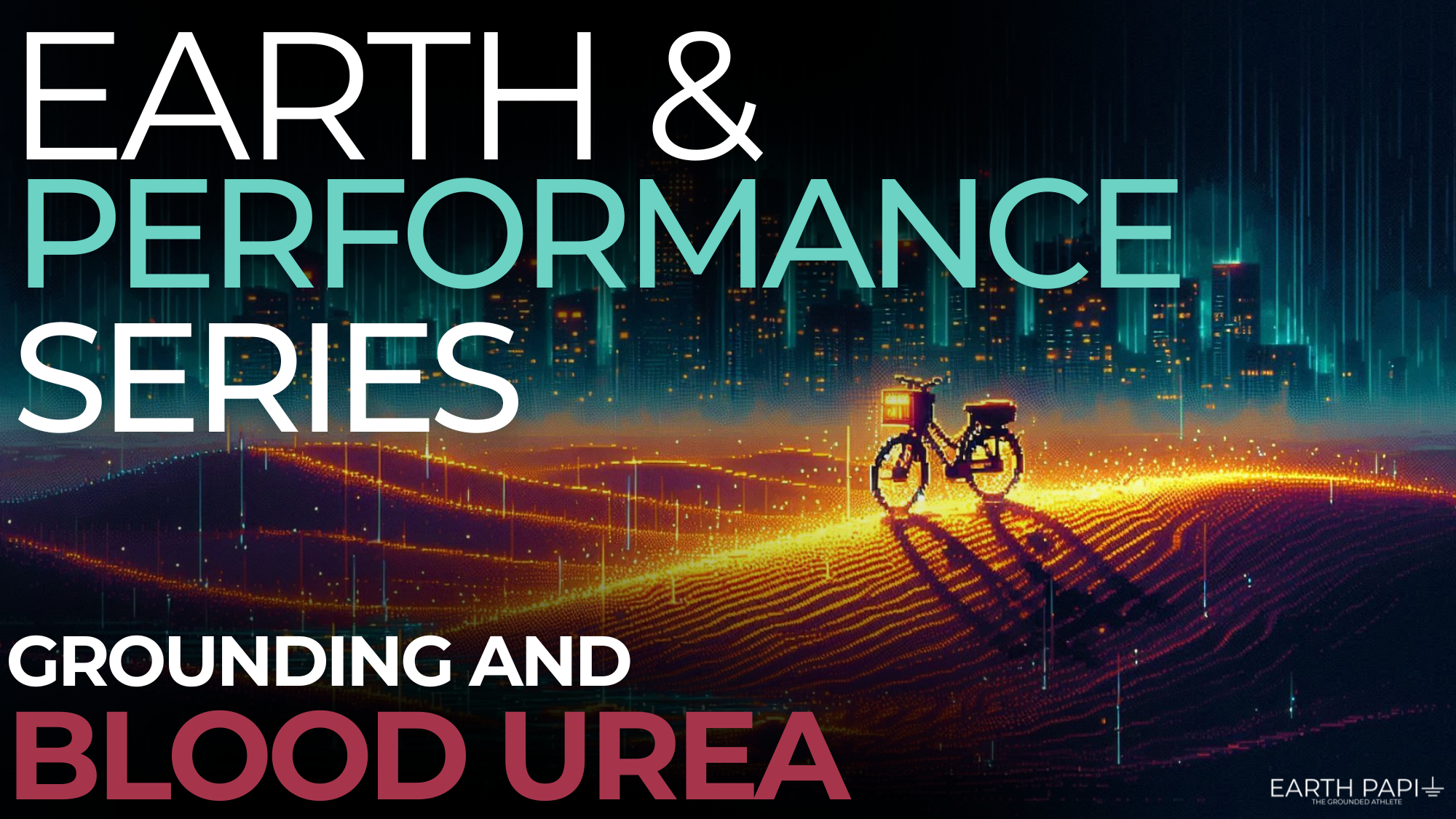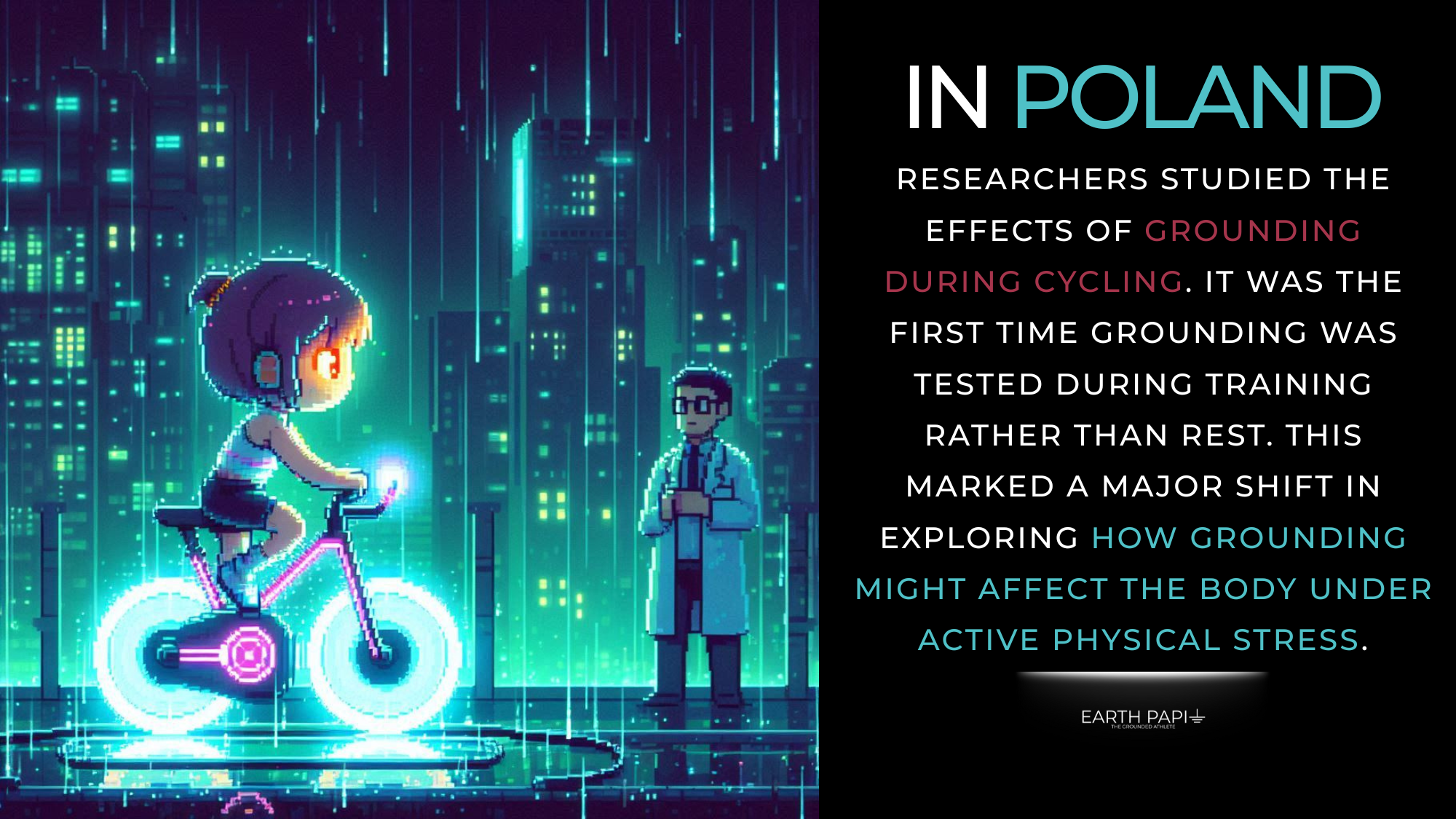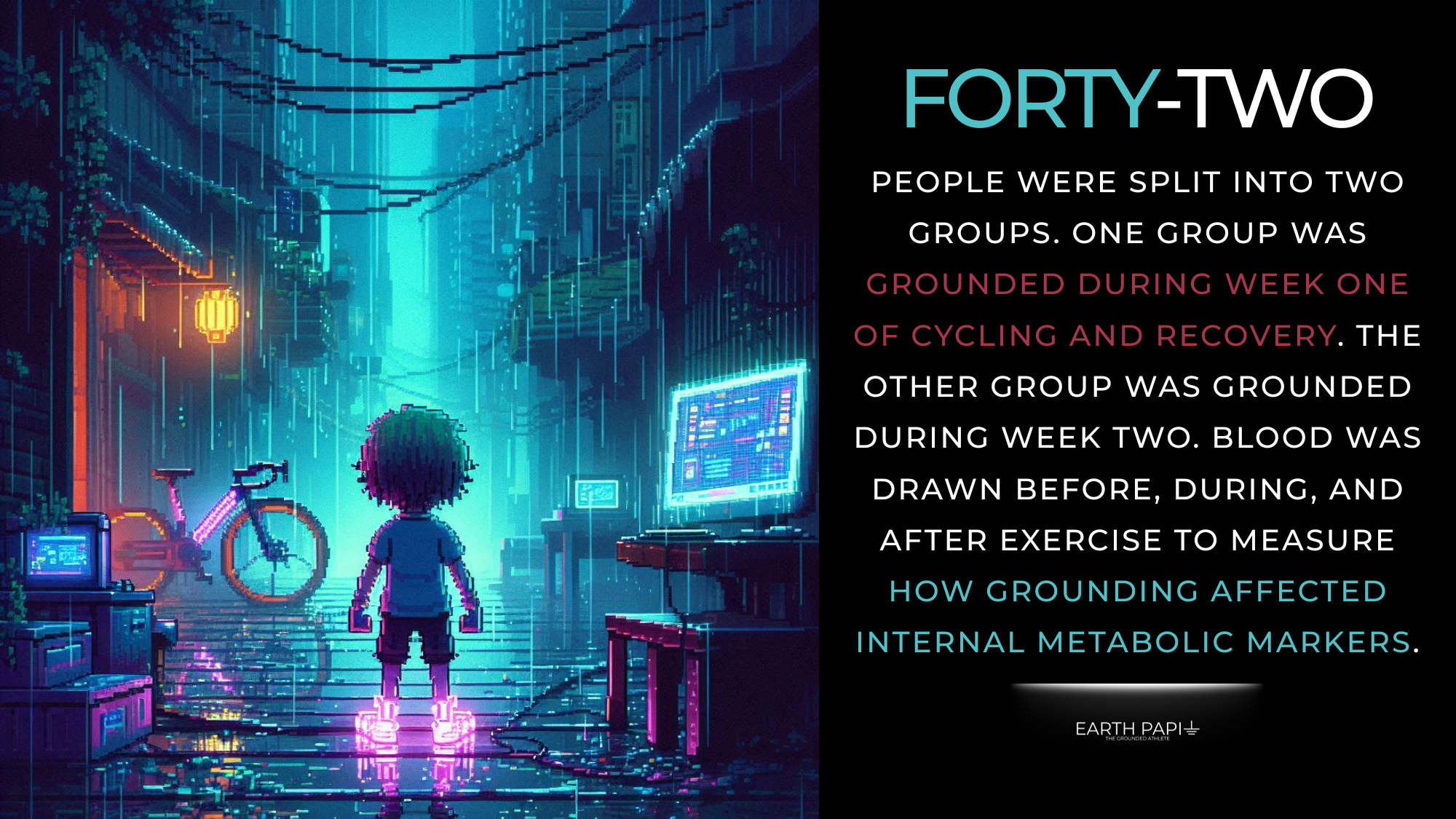Earth & Performance Series - Grounding and Blood Urea
We’ll conclude the Earth & Performance series in Poland!
At the University of Physical Education and Sport in Gdansk, Poland, Sokal and colleagues conducted a landmark study. It was the first to examine how grounding affects the body during exercise, with a focus on cycling. Until this point, most research had looked at grounding during rest or recovery. This study moved into new territory.. what happens when you're grounded while training?
We know that exercise increases energy demand and leads to protein breakdown. Specifically, it accelerates amino acid oxidation. Amino acids are the building blocks of proteins. They're organic compounds, each with a distinct side chain, and they’re essential for tissue repair and growth. During activity, the body taps into these amino acids as an energy source. As this process unfolds, waste products like urea and creatinine build up and are excreted.
The urea cycle handles that waste. It occurs in the liver and kidneys and removes toxic nitrogen produced during protein metabolism. This cycle converts ammonia into urea, which is filtered by the kidneys and eliminated in urine. If the cycle doesn’t function efficiently — for example, in cases of extreme protein intake without sufficient fat or carbs, as in rabbit starvation — ammonia can build up. That can lead to nausea, fatigue, and even death if unmanaged. The urea cycle is vital for maintaining nitrogen balance and preventing toxicity.
In this study, 42 participants were randomly assigned to one of two groups. One group was grounded during the first week of 30-minute cycling sessions and during recovery. The other was grounded during the second week. Blood samples were collected before exercise, during it, and after recovery.
The results were clear. Those grounded during exercise and relaxation had significantly lower blood urea levels compared to the control group. Their creatinine levels stayed steady during exercise and dropped lower during recovery. This suggests that grounding influences not only the energy system but also nitrogen processing and kidney filtration.
Urea is filtered by the kidneys. About half is reabsorbed, while the rest is excreted. The lower urea levels observed in grounded subjects might mean more efficient excretion or less reabsorption. More interestingly, they may also point to reduced urea formation in the first place, meaning less protein breakdown in the liver. Grounding may suppress catabolism and shift the body into a more favorable recovery state.
The authors noted that grounding alters the body's electrical and fluid environment. That matters because kidney filtration is influenced by the electrochemical gradient and membrane charge. The glomerular basement membrane is negatively charged and resists large negatively charged molecules. Grounding may subtly shift these potentials and change the kidney’s filtering behavior.
Creatinine, a byproduct of creatine metabolism in muscle, follows a different route. It's filtered by the kidneys but almost none is reabsorbed. Blood creatinine levels are used as a marker of kidney function and, indirectly, of muscle breakdown. The study showed that grounded participants had no change in creatinine during exercise, but significantly lower levels during recovery. This could mean that less muscle creatine was being broken down, which would be a sign of preserved muscle integrity.
So how does this all tie together?
During exercise, the body ramps up protein breakdown and amino acid use. That’s expected. But when subjects were grounded, blood markers like urea and creatinine dropped. This suggests a shift toward reduced protein catabolism and possibly a better nitrogen balance. And that matters because maintaining a positive nitrogen balance is key for building muscle and recovering efficiently. If breakdown outpaces synthesis, you lose muscle. But if synthesis holds strong and breakdown is reduced, you move forward. That’s what grounding appears to support.
This was the fourth study in our series showing measurable benefits of grounding — not just during rest, but during training itself. Reduced urea and creatinine. Lower inflammation. Less breakdown. More balance.
We’ve also seen in earlier work that grounding reduces blood viscosity. That’s relevant here too, since blood viscosity increases during exercise and contributes to inflammation. Reducing it may further support recovery and nutrient delivery post-exercise.
As a whole, the data suggest that grounding may reduce inflammation, limit muscle damage, preserve muscle creatine, and support more efficient recovery. For athletes, this has big implications. Whether you're training for performance, longevity, or recovery, grounding could be a missing piece of the puzzle.
I’ve personally come to believe that many modern athletes experience delayed onset muscle soreness (DOMS) at unnatural levels. Some damage is necessary — that’s how adaptation happens. But too much damage stalls progress. And I believe the excess comes from training in an electrically insulated state. Grounding reduces that damage. It returns the body to its natural state. Not pain-free, just efficient.
Reading about this helps. But it won’t change anything unless you apply it. Grounding needs to be experienced. Train grounded. Recover grounded. You’ll push harder, recover faster, and get more done with less damage. That’s how you train at the edge without falling off it.
This is what grounding allows. This is the natural state of the athlete — the grounded athlete.
Up next - we explore what grounding means for the immune system, in the Earth & Immune Series.
As always, if you’re interested in learning more about grounding, check out Earth & Water.
References:
M. J. Rennie, “Influence of exercise on protein and amino acid metabolism,” in Handbook of Physiology, Section 12 Exercise : Regulation and Integration of Multiple Systems, L. B. Rowel and J. T. Shephard, Eds., pp. 995–1035, Oxford University Press, New York, NY, USA, 1996.
Y. Shimomura, T. Honda, M. Shiraki et al., “Branched-chain amino acid catabolism in exercise and liver disease,” Journal of Nutrition, vol. 136, supplement 1, pp. 250S–253S, 2006.
J. Calles-Escandon, J. J. Cunningham, P. Snyder et al., “Influence of exercise on urea, creatinine, and 3-methylhistidine excretion in normal human subjects,” The American Journal of Physiology, vol. 246, no. 4, pp. E334–E338, 1984.
S. E. Foran, K. B. Lewandrowski, and A. Kratz, “Effects of exercise on laboratory test results,” Laboratory Medicine, vol. 34, no. 10, pp. 736–742, 2003.
Barmore W, Azad F, Stone WL. Physiology, Urea Cycle. [Updated 2022 May 15]. In: StatPearls [Internet]. Treasure Island (FL): StatPearls Publishing; 2022 Jan-. Available from: https://www.ncbi.nlm.nih.gov/books/NBK513323/
A. A. Ferrando, D. Paddon-Jones, and R. R. Wolfe, “Alterations in protein metabolism during space flight and inactivity,” Nutrition, vol. 18, no. 10, pp. 837–841, 2002.
V. Kumar, P. Atherton, K. Smith, and M. J. Rennie, “Human muscle protein synthesis and breakdown during and after exercise,” Journal of Applied Physiology, vol. 106, no. 6, pp. 2026–2039, 2009.
A. C. Guyton and J. E. Hall, “Urine formation by the kidneys,” in Textbook of Medical Physiology, pp. 307–346, Elsevier Saunders, Philadelphia, Pa, USA, 11th edition, 2006.
A. C. Guyton and J. E. Hall, “Protein metabolism,” in Textbook of Medical Physiology, pp. 852–857, Elsevier Saunders, Philadelphia, 11th edition, 2006.
Kashani K, Rosner MH, Ostermann M. Creatinine: From physiology to clinical application. Eur J Intern Med. 2020 Feb;72:9-14. doi: 10.1016/j.ejim.2019.10.025. Epub 2019 Nov 8. PMID: 31708357.
Sokal P, Jastrzębski Z, Jaskulska E, Sokal K, Jastrzębska M, Radzimiński L, Dargiewicz R, Zieliński P. Differences in Blood Urea and Creatinine Concentrations in Earthed and Unearthed Subjects during Cycling Exercise and Recovery. Evid Based Complement Alternat Med. 2013;2013:382643. doi: 10.1155/2013/382643. Epub 2013 Aug 27. PMID: 24066011; PMCID: PMC3771483.
Brown, Richard & Chevalier, Gaetan. (2015). Grounding the Human Body during Yoga Exercise with a Grounded Yoga Mat Reduces Blood Viscosity. Open Journal of Preventive Medicine. 05. 159-168. 10.4236/ojpm.2015.54019.
(additional study references added from here) Nakrani MN, Wineland RH, Anjum F. Physiology, Glucose Metabolism. [Updated 2022 Jul 25]. In: StatPearls [Internet]. Treasure Island (FL): StatPearls Publishing; 2022 Jan-. Available from: https://www.ncbi.nlm.nih.gov/books/NBK560599/
Andersen LW, Mackenhauer J, Roberts JC, Berg KM, Cocchi MN, Donnino MW. Etiology and therapeutic approach to elevated lactate levels. Mayo Clin Proc. 2013 Oct;88(10):1127-40. doi: 10.1016/j.mayocp.2013.06.012. PMID: 24079682; PMCID: PMC3975915.
Witek K, Ścisłowska J, Turowski D, Lerczak K, Lewandowska-Pachecka S, Pokrywka A. Total bilirubin in athletes, determination of reference range. Biol Sport. 2017 Mar;34(1):45-48. doi: 10.5114/biolsport.2017.63732. Epub 2016 Dec 1. PMID: 28416897; PMCID: PMC5377560.
Bergh U, Sjödin B, Forsberg A, Svedenhag J. The relationship between body mass and oxygen uptake during running in humans. Med Sci Sports Exerc. 1991 Feb;23(2):205-11. PMID: 2017016.
Porter RK, Brand MD. Cellular oxygen consumption depends on body mass. Am J Physiol. 1995 Jul;269(1 Pt 2):R226-8. doi: 10.1152/ajpregu.1995.269.1.R226. PMID: 7631898.
Benedik PS, Hamlin SK. The physiologic role of erythrocytes in oxygen delivery and implications for blood storage. Crit Care Nurs Clin North Am. 2014 Sep;26(3):325-35. doi: 10.1016/j.ccell.2014.04.002. PMID: 25169686.
Jensen FB. The dual roles of red blood cells in tissue oxygen delivery: oxygen carriers and regulators of local blood flow. J Exp Biol. 2009 Nov;212(Pt 21):3387-93. doi: 10.1242/jeb.023697. PMID: 19837879.
Louajri A, Harraga S, Toubin G, Kantelip JP. Red blood cell metabolism and hemoglobin oxygen affinity. Effect of vinburnine on normobaric hypoxic rats. Biol Pharm Bull. 1999 Aug;22(8):773-4. doi: 10.1248/bpb.22.773. PMID: 10480311.
MacDonald R. Red cell 2,3-diphosphoglycerate and oxygen affinity. Anaesthesia. 1977 Jun;32(6):544-53. doi: 10.1111/j.1365-2044.1977.tb10002.x. PMID: 327846.
Chevalier G. Changes in pulse rate, respiratory rate, blood oxygenation, perfusion index, skin conductance and their variability induced during and after grounding human subjects for 40 minutes. J Alter Compl Med. 2010; 16:81-87. DOI: 10.1089/acm. 2009.0278.
Sokal, P.A., Jastrzębski, Z., Sokal, K., Dargiewicz, R., Jastrzębska, M.E., & Radzimiński, Ł. (2016). Earthing modulates glucose and erythrocytes metabolism in exercise. International journal of physical education, sports and health, 3, 06-13.










